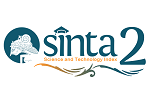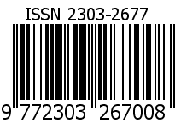Media literacy's role toward Roda Jari Mas Radio listeners in dealing with disasters
Abstract
Pangandaran is an area that is vulnerable to tsunami disasters. It is caused the sonic activity of the Indo-Australian plate’s in the southern coastal regio. Roda Jari Mas (RJM) Radio as a community radio has the role of informing the community about tsunami disaster information. This study aims to determine the role of media literacy for RJM Radio listeners in dealing with disasters in Pangandaran Regency. This research used a qualitative approach with a case study research method through Focus Group Discussion (FGD) on 9 participants. The results stated that the most widely used media exposure of Pangandaran people is radio, which is RJM Radio, television, and social media. Sources of disaster information obtained by the Pangandaran community include television and social media (if a disaster occurs). There are three aspects influenced people's readiness to face disasters, namely media exposure, government attention, and infrastructure. Social media can be a source of disaster information. The community has participated in several disaster mitigation simulations, but has not been supported by adequate infrastructure. The conclusion of the study is that the Pengandaran community has low media exposure could have an impact on a lack of knowledge and low levels of government attention, which resulted in a lack of disaster preparedness training, not to mention low levels of infrastructure. All of these things had a big impact on one thing, namely low preparedness to face disasters.
Keywords
Full Text:
PDFReferences
Badan Nasional Penanggulangan Bencana (BNPB). (2023). Profil bencana Indonesia. Badan Nasional Penanggulangan Bencana (BNPB). https://dibi.bnpb.go.id/
Bencana Kesehatan. (2014). Gempa dan tsunami Pangandaran. Bencana Kesehatan. https://bencana-kesehatan.net/index.php/2-uncategorised/734-gempa-dan-tsunami-pangandaran
Bisjoe, A. R. H. (2018). Menjaring data dan informasi penelitian melalui Focus Group Discussion (FGD): Belajar dari praktek lapangan. Buletin Eboni, 15(1), 17–27. http://ejournal.forda-mof.org/ejournal-litbang/index.php/buleboni/article/view/5117/4542
Blackwood, G., Hardy, A., Dodd, B., Ooi, C. S., & Williams, K. (2023). Natural disaster on Instagram: Examining representations of the 2018–2019 Tasmanian fires. Annals of Tourism Research Empirical Insights, 4(1), 1–8. https://doi.org/10.1016/j.annale.2022.100082
BPBD Kabupaten Bogor. (2022). Mitigasi adalah upaya mengurangi risiko, berikut langkah-langkah dan contohnya. BPBD Kabupaten Bogor. https://bpbd.bogorkab.go.id/mitigasi-adalah-upaya-mengurangi-risiko-berikut-langkah-langkah-dan-contohnya/
Peraturan Bupati Pangandaran Nomor 60 Tahun 2020 tentang Rencana Kerja Pemerintah Daerah Kabupaten Pangandaran Tahun 2021, Pub. L. No. Pangandaran. 27 Juli 2020. (2020). https://bkad.pangandarankab.go.id/wp-content/uploads/Perbup-RKPD-Kab.-Pangandaran-Tahun-2021-Cetak.pdf
Chandramohan, P., Anu, A., Vaigaiarasi, V., & Dharmalingam, K. (2017). Environmental management and emergency preparedness plan for tsunami disaster along Indian coast. The International Journal of Ocean and Climate Systems, 8(3), 144–152. https://doi.org/10.1177/1759313117708253
Chen, C. C., & Wang, H.-C. (2022). Using community information for natural disaster alerts. Journal of Information Science, 48(5), 1–15. https://doi.org/10.1177/0165551520979870
Crowe, S., Cresswell, K., Robertson, A., Huby, G., Avery, A., & Sheikh, A. (2011). The case study approach. BMC Medical Research Methodology, 11(100), 1–9. https://doi.org/10.1186/1471-2288-11-100
Damayani, N. A., Saepudin, E., Rusmana, A., Rizal, E., & McArthur, J. M. B. (2022). The local wisdom-based disaster mitigation literacy of the indigenous Pangandaran Community. Jurnal Studi Komunikasi (Indonesian Journal of Communications Studies), 6(2), 424–439. https://doi.org/10.25139/jsk.v6i2.4862
Dewi, R. S., & Anggarasari, N. H. (2020). Mitigasi bencana pada anak usia dini. Early Childhood: Jurnal Pendidikan, 3(1), 68–77. https://journal.umtas.ac.id/index.php/EARLYCHILDHOOD/article/view/438/476
Dhakal, S. P. (2018). Analysing news media coverage of the 2015 Nepal earthquake using a community capitals lens: Implications for disaster resilience. Disasters, 42(2), 294–313. https://doi.org/10.1111/disa.12244
Fadillah, M., Sugiharti, D. K., & Radjab, A. M. (2020). Peranan pemerintah dalam pelaksanaan mitigasi bencana. MAGISTRA: Law Review, 1(02), 136–151. https://doi.org/10.35973/malrev.v1i2.1604
Gregg, H. R., Restubog, S. L., Dasborough, M., Xu, C. (Melody), Deen, C. M., & He, Y. (2022). When disaster strikes! An interdisciplinary review of disasters and their organizational consequences. Journal of Management, 48(6), 1382–1429. https://doi.org/10.1177/01492063221076808
Gumilar, G., & Zulfan, I. (2014). Penggunaan media massa dan internet sebagai sarana penyampaian informasi dan promosi oleh pengelola industri kecil dan menengah di Bandung. Jurnal Kajian Komunikasi, 2(1), 85–92. https://doi.org/10.24198/jkk.v2i1.6054
Indahsari, C. A., Zafirah, A., Ardiansyah, G., & Susanto, A. P. (2021). Instagram dan kebencanaan: Analisis isi akun Instagram @mdmc.magelang sebagai media informasi kebencanaan di Kabupaten Magelang. Borobudur Communication Review, 1(2), 78–86. https://doi.org/10.31603/bcrev.6372
Ismana, D. R., Baehera, S., Fitrianto, A., Sartono, B., & Oktarina, S. D. (2022). Penggerombolan desa di Jawa Barat berdasarkan daerah rawan bencana. Jurnal Statistika Dan Aplikasinya, 6(2), 243–252. https://doi.org/10.21009/JSA.06210
Javed, T., & Said, F. (2022). Business response to natural disaster mitigation (COVID-19): A case from Pakistan. Sage Open, 12(1), 1–12. https://journals.sagepub.com/doi/epub/10.1177/21582440211069388
Jemli, R. (2021). The importance of natural disasters’ governance for macroeconomic performance and countries resilience. International Journal of Disaster Resilience in the Built Environment, 12(4), 387–399. https://doi.org/10.1108/IJDRBE-05-2020-0035
Lee, D. W. (2020). An exploratory assessment of infrastructure resilience to disasters. International Journal of Disaster Resilience in the Built Environment, 11(4), 519–533. https://doi.org/10.1108/IJDRBE-02-2019-0006
Lestari, E. (2019). Kajian strategi mitigasi bencana tsunami dan kesiapsiagaan publik di Desa Pangandaran (Skripsi) [Insitut Teknologi Nasional, Bandung]. http://eprints.itenas.ac.id/495/
Madianou, M. (2015). Digital inequality and second-order disasters: Social media in the typhoon Haiyan recovery. Social Media + Society, 1(2), 1–11. https://doi.org/10.1177/2056305115603386
Muhlisah, N., Arpin, R. M., & Mukarramah, S. K. (2021). Sosialisasi mitigasi bencana alam. Abdimas Toddopuli: Jurnal Pengabdian Pada Masyarakat, 2(2), 107–111. https://doi.org/10.30605/atjpm.v2i2.1232
My Pangandaran. (2017). Tentang Pangandaran. My Pangandaran. https://www.mypangandaran.com/sekilas-pangandaran
Permana, I. Y. (2021). Pendidikan keaksaraan dasar literasi mitigasi bencana. Jurnal AKRAB, 12(1), 18–27. https://doi.org/10.51495/jurnalakrab.v12i1.372
Prayogi, W. A., & Asyiawati, Y. (2021). Kajian kerentanan pantai terhadap pengembangan wilayah pesisir Pangandaran. Jurnal Riset Perencanaan Wilayah Dan Kota, 1(2), 89–98. https://doi.org/10.29313/jrpwk.v1i2.370
Rahmah, S., & I. (2022). Manajemen bencana dalam penanganan pasca bencana BPBD Kabupaten Aceh Barat. Journal of Social Politics and Governance (JSPG), 4(1), 24–37. https://doi.org/10.24076/JSPG.2022v4i1.776
Rijali, A. (2018). Analisis data kualitatif. Alhadharah: Jurnal Ilmu Dakwah, 17(33), 81–95. https://doi.org/10.18592/alhadharah.v17i33.2374
Schweizer, P.-J., & Renn, O. (2019). Governance of systemic risks for disaster prevention and mitigation. Disaster Prevention and Management: An International Journal, 28(6), 862–874. https://doi.org/10.1108/DPM-09-2019-0282
Sharma, S. (2021). Exploring disaster mitigation in India: A financial viewpoint. Emerging Economy Studies, 7(1), 7–22. https://doi.org/10.1177/23949015211057915
Simione, L., & Gnagnarella, C. (2020). Differences between health workers and general population in risk perception, behaviors, and psychological distress related to COVID-19 spread in Italy. Frontiers in Psychology, 11(2), 1–17. https://doi.org/10.3389/fpsyg.2020.02166
Sjuchro, D. W., Khadijah, U. L. S., Hardian, M. S. D., & Rukmana, E. N. (2019). Komunikasi kebencanaan Radio Bunut sebagai radio komunitas di Sukabumi. Jurnal Kajian Komunikasi, 7(2), 145–158. https://doi.org/10.24198/jkk.v7i2.20737
Vicari, R., & Komendatova, N. (2023). Systematic meta-analysis of research on AI tools to deal with misinformation on social media during natural and anthropogenic hazards and disasters. Humanities and Social Sciences Communications, 10(1), 1–14. https://doi.org/10.1057/s41599-023-01838-0
Wardiana, D. W., Khadijah, U. L. S., & Rukmana, E. N. (2018). Dokumentasi budaya ngaruat lembur di Radio RASI FM. Jurnal Kajian Informasi Dan Perpustakaan, 6(1), 43–58. https://doi.org/10.24198/jkip.v6i1.15325
Xu, D., Zhuang, L., Deng, X., Qing, C., & Yong, Z. (2020). Media exposure, disaster experience, and risk perception of rural households in earthquake-stricken areas: Evidence from rural China. International Journal of Environmental Research and Public Health, 17(9), 1–20. https://doi.org/10.3390/ijerph17093246
Yan, L. (Lucy), & Pedraza‐Martinez, A. J. (2019). Social media for disaster management: Operational value of the social conversation. Production and Operations Management, 28(10), 2514–2532. https://doi.org/10.1111/poms.13064
DOI: https://doi.org/10.24198/jkip.v12i1.51256
Refbacks
- There are currently no refbacks.
Copyright (c) 2024 Author(s)

This work is licensed under a Creative Commons Attribution-ShareAlike 4.0 International License.
Jurnal Kajian Informasi & Perpustakaan Indexed by:
Jurnal Kajian Informasi & Perpustakaan
Program Studi Perpustakaan dan Sains Informasi d.h. Program Studi Ilmu Perpustakaan
Fakultas Ilmu Komunikasi, Universitas Padjadjaran
Jl. Raya Bandung-Sumedang Km. 21 Jatinangor, Sumedang, Indonesia 45363
WA: +62 813-1323-7581 (Chat Only)
Telepon: +62227796954
Faksimile: +62227794122
email: jkip.fikom@unpad.ac.id
Jurnal Kajian Informasi & Perpustakaan is licensed under a Creative Commons Attribution-ShareAlike 4.0 International License
Jurnal Kajian Informasi & Perpustakaan supervised by:












2.png)
.png)



